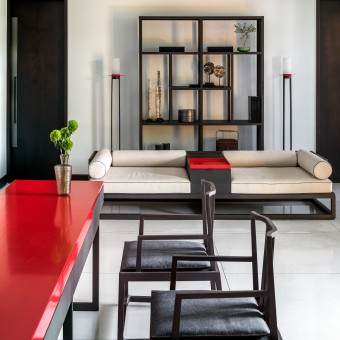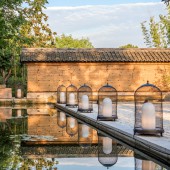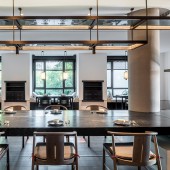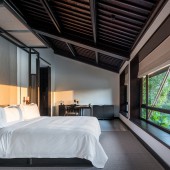
| THE AWARD |
| CATEGORIES |
| REGISTRATION |
| SUBMIT YOUR WORK |
| ENTRY INSTRUCTIONS |
| TERMS & CONDITIONS |
| PUBLICATIONS |
| DATES & FEES |
| METHODOLOGY |
| CONTACT |
| WINNERS |
| PRESS ROOM |
| GET INVOLVED |
| DESIGN PRIZE |
| DESIGN STORE |
| THE AWARD | JURY | CATEGORIES | REGISTRATION | PRESS | WINNERS | PUBLICATIONS | ENTRY INSTRUCTIONS |
Savoir Resort Hotel Interior Design by Karen Chang |
Home > Winners > Design #77829 >Interview |
 |
|
FS: What is the main principle, idea and inspiration behind your design?
KC: “philosophy of a hermit” is one of the most important realms in the traditional spiritual realm of the Chinese. It is also the main principle in the design process, in addition to "functions, materials are in line with the natural way." The design is inspired by the natural beauty of Xixi Wetland Park, the local history and culture and the charm of architecture itself.
FS: What has been your main focus in designing this work? Especially what did you want to achieve?
KC: Focus on how to turn an old house into a holiday space suitable for contemporary people. Always adheres to the idea that Contemporary Chinese architecture should not be conservative, but should convey the spirit of contemporary living.
FS: What are your future plans for this award winning design?
KC: No plans yet.
FS: How long did it take you to design this particular concept?
KC: It takes 6 months.
FS: Why did you design this particular concept? Was this design commissioned or did you decide to pursuit an inspiration?
KC: This concept is based on local cultural history.
FS: Is your design being produced or used by another company, or do you plan to sell or lease the production rights or do you intent to produce your work yourself?
KC: This concept is based on local cultural history.
FS: What made you design this particular type of work?
KC: The unique humanities and natural geography of Xixi Wetland Park deeply touched me.
FS: Where there any other designs and/or designers that helped the influence the design of your work?
KC: The architecture of Savoir Resort was designed by Jie Zheng of Aman Resort. In the early stage of project planning, I communicated with Jie Zheng. His planning of architecture has affect on my interior design.
FS: Who is the target customer for his design?
KC: A person who is busy in the city and wants to relax on vacation.
FS: What sets this design apart from other similar or resembling concepts?
KC: Nowadays, many old architectures have been rebuilt, either to completely recreate the old architecture, or to completely change their face, and to see that Savoir Resort perfectly balances the new and the old, from the perspective of modern human settlements to create a modern yet there is a Chinese-style habit of using space while meeting the holiday atmosphere.
FS: How did you come up with the name for this design? What does it mean?
KC: The name is determined by the owner.
FS: Which design tools did you use when you were working on this project?
KC: Paper and Pen and Image Model.
FS: What is the most unique aspect of your design?
KC: The Hotel is designed on the basis of traditional folk houses in the south lower reaches of the Yangtze River following five years of meticulous pondering. It tends to create a free and open space order more in line with the characteristics of modern times, starting from the lifestyle of modern people and revolving around the “philosophy of a hermit” in traditional Chinese culture, in its design. The subtraction method is adopted to present the design and the spatial vocabulary has been simplified as far as possible so as to play down the sense of form of indoor objects or hard decoration. The large area for windows breaks the sense of enclosure in a traditional building, fusing the indoor and the outdoor space as a whole.
FS: Who did you collaborate with for this design? Did you work with people with technical / specialized skills?
KC: The company's professional design team worked on the design together.
FS: What is the role of technology in this particular design?
KC: Make design details more precise and easier to implement.
FS: Is your design influenced by data or analytical research in any way? What kind of research did you conduct for making this design?
KC: The design of Savoir Resort is based on our research on its local culture. We have consulted a large number of books and obtained a lot of professional information through the network.
FS: What are some of the challenges you faced during the design/realization of your concept?
KC: Hotel owners and construction companies are big challenges
FS: How did you decide to submit your design to an international design competition?
KC: Because of this award, it has a high reputation in China, and the international judges invited are more professional, so we decided to enter the competition. In addition, what you see is that Savoir Resort is a boutique project that we have built in 5 years, and we hope that it will be seen by more people.
FS: What did you learn or how did you improve yourself during the designing of this work?
KC: I learned patience and persistence in design.
FS: Any other things you would like to cover that have not been covered in these questions?
KC: None.
FS: Thank you for providing us with this opportunity to interview you.
A' Design Award and Competitions grants rights to press members and bloggers to use parts of this interview. This interview is provided as it is; DesignPRWire and A' Design Award and Competitions cannot be held responsible for the answers given by participating designers.
| SOCIAL |
| + Add to Likes / Favorites | Send to My Email | Comment | View Press-Release |




